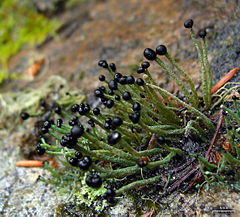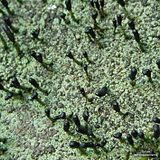- Pilophorus acicularis
-
Pilophorus acicularis 
Scientific classification Kingdom: Fungi Division: Ascomycota Class: Lecanoromycetes Order: Lecanorales Family: Cladoniaceae Genus: Pilophorus Species: P. acicularis Binomial name Pilophorus acicularis
(Ach.) Th.Fr. (1857)Synonyms[1] Baeomyces acicularis Ach. (1803)
Cenomyces acicularis (Ach.) Ach. (1810)
Cladonia acicularis (Ach.) Fr. (1831)
Stereocaulon aciculare (Ach.) Tuck. (1845)
Pilophoron aciculare (Ach.) Nyl. (1857)Pilophorus acicularis, commonly known as the nail lichen or the devil's matchstick, is a species of lichen in the Cladoniaceae family. It was originally described in 1803, and transferred to the genus Pilophorus in 1857. A fructicose (shrub-like) species, it grows directly on silicate rocks in dense clusters. The lichen starts out as a granular crust on the rock surface, and develops stalks, or pseudopodetia, up to 3 cm (1.2 in) tall and about 1 mm thick that have rounded black apothecia at the tips. The stalks are erect and curved so as to appeared combed. It is found on the west coast of North America up to Alaska, and in eastern Eurasia. In addition to green algae, the lichen contains cyanobacteria that help contribute to soil fertility by supplying fixed nitrogen.
Contents
History, taxonomy and phylogeny
Several members of the family Sphaerophoraceae
Cladonia bellidiflora (Cladoniaceae)
Pilophorus acicularis (Cladoniaceae)
Stereocaulon ramulosum (Stereocaulaceae)
Lecanora dispersa (Lecanoraceae)
Phylogeny and relationships of P. acicula and other species of Lecanorales based on analysis of nuclear SSU rDNA sequences. Familial placement is shown in parenthesis.[2] The species was first described in 1803 as Baeomyces acicularis by the Swedish botanist and "father of lichenology" Erik Acharius.[3] The taxon was transferred to several different genera in the next few decades resulting in several synonyms, including Cenomyces acicularis (by Acharius in 1810), Cladonia acicularis (Elias Magnus Fries in 1831), and Stereocaulon aciculare (Edward Tuckerman in 1845).[1] Elias Fries's son Thore Magnus transferred the species to his then newly created genus Pilophorus in 1857.[4] William Nylander also published the combination Pilophorus acicularis in 1857,[5] but later analysis suggested that Fries's combination was published first, and under the Principle of Priority, the correct citation of the species is Pilophorus acicularis (Ach.) Th.Fr. (1857).[6]
The genus Pilophorus was until recently considered to be a member of the Stereocaulaceae family by some authors.[7][8][9] Analysis of small subunit ribosomal DNA sequences showed P. acicularis to be more closely related to the Cladoniaceae, rather than the Stereocaulaceae.[10]
The specific epithet aciculare is derived from the Latin acicularis, meaning "needle-like".[11] The lichen is commonly known as the "devil's matchstick";[12] the common name for the genus—"nail lichen"—is also used.[13]
Description
The thallus is the vegetative body of a lichen that contains the lichen mycobiont (fungus) and the photobiont (algae and/or cyanobacteria). In P. acicularis, the primary thallus (thallus horizontalis) is spread out like a granular crust on the surface of its substrate. It is light green when young, but becomes gray in age or when dry.[14] The pseudopodetia (upright stalk-like extensions of the thallus made of vegetative tissue) range from 0.5 to 3 cm (0.2 to 1.2 in) high, and are about 1 mm thick; they grow in dense clusters. Most pseudopodetia are either unbranched or forked into two branches, with the stalks curved so as to appear as if combed; less frequently, they are erect like pins, and up to 1 cm (0.4 in) tall. Some specimens are highly branched in the upper part of the pseudopodetia, causing them to bear some resemblance to P. robustus, although this morphology is uncommon. Internally, the pseudopodetia are solid when young, becoming hollow with age, and are composed of long, thin, highly gelatinized hyphae with narrow cavities about 0.5 μm wide. The lower part of older pseudopodetia becomes blackened internally. The algal layer is not continuous—contrasting with lichen species that have thalli that stratify into discrete tissue types, including a photobiont layer—and occurs with the mycobiont in the form of granules. These granules may be absent from some parts of the thallus surface. Pycnidia (flask-like structures, resembling perithecia, in which conidia are produced) occur in the tips of small sterile pseudopodetia or in the tips of small lateral branches of older pseudopodetia.[7]
The conidiophores of P. acicularis are 30 μm long, and unbranched. They have terminal sickle-shaped conidia that measure 6 by 1 μm. The apothecia (reproductive structures covered with the spore-producing asci) are abundant, usually with one or several on the tips of the pseudopodetia. They are black, hemispherical or roughly triangular, and measure up to 1.5 mm in diameter. The hymenium (the fertile spore-bearing layer of cells containing the asci) is up to 240 μm thick, and about two-thirds of it is pigmented; the lower part of the hymenium is sterile, consisting of only paraphyses. The asci are eight-spored. The ascospores are rounded when young, becoming spindle-shaped when mature, with dimensions of 21.0–29.5 by 4.5–5.5 μm. The generative tissue (hyphae that eventually forms the thallus) is closely interwoven with short, broad cells that have large cavities. The generative tissue is pigmented black-brown, with the color being most intense below the paraphyses, becoming less so towards the stalk region.[7]
Pilophorus acicularis is a tripartite lichen—containing a fungus, a green alga, and a cyanobacterium. Cephalodia (lichenized aggregations of nitrogen-fixing cyanobacteria) are present on the primary thallus; smaller cephalodia are also on the pseudopodetia. Hemispherical to irregularly shaped, and light to dark brown in color, they contain species from the genus Nostoc.[6] The green algal photosynthetic symbiont (photobiont) associated with P. acicularis is Asterochloris magna (formerly Trebouxia magna).[15][16]
Similar species
Pilophorus acicularis can be separated from similar species by its tall pseudopodetia. It may be confused with P. robustus, especially in material from Alaska where both species occur together. Usually, the different branching (umbellate in P. robustus versus dichotomous in P. acicularis) and the lack of a columella (an internal, column-shaped structure) in longitudinal sections of the pseudopodetia of P. acicularis make it relatively easy to distinguish between the two.[7]
Pilophyllus clavatus, a species found in Western North America, Japan, Taiwan and South Korea, resembles P. acicularis, but it has much shorter pseudopodetia—up to 1.5 cm (0.6 in) long.[17]
Habitat and distribution
The lichen typically grows on silicate stone, rarely on decaying wood.[7] It is usually in partial shade in openings in low to mid-elevation moist forests, and is also frequently found in rocky roadcuts.[14] Lichens with cephalodia are capable of fixing nitrogen, and contribute nitrogen to the ecosystem.[18]
P. acicularis is probably the most abundant species of the genus. Most specimens have been found on the west coast of North America as far North as Alaska,[19] but it is been reported most frequently from British Columbia and Washington. The species is found in China,[20] Japan,[21] Korea,[22] and Taiwan,[23] and has also been reported from the Russian arctic.[24] In general, P. acicularis seems to prefer an oceanic climate without extremely low temperatures, at least in comparison with other species of the genus. This assumption is supported by the fact that P. acicularis is found more southerly (34 findings in California) than all other species and is less frequently found in northern Alaska where, for example, P. robustus and P. vegae are more common. P. acicularis is rare east of the Rocky Mountains.[7]
References
- ^ a b "Baeomyces acicularis Ach. 1803". MycoBank. International Mycological Association. http://www.mycobank.org/MycoTaxo.aspx?Link=T&Rec=458386. Retrieved 2011-01-01.
- ^ Wedin M, Döring H. (1999). "The phylogenetic relationship of the Sphaerophoraceae, Austropeltum and Neophyllis (lichenized Ascomycota) inferred by SSU rDNA sequences". Mycological Research 103 (9): 1131–37. doi:10.1017/S0953756298008223.
- ^ Acharius E. (1803) (in Latin). Methodu qua Omnes Detectos Lichenes. Stockholm: impensis F.D.D. Ulrich, typis C.F. Marquard . p. 328. http://books.google.ca/books?id=4hMAAAAAQAAJ&ots=uxpQQwitAV&dq=Methodu%20qua%20Omnes%20Detectos%20Lichenes&pg=PA328#v=onepage&q&f=false.
- ^ Fries TM. (1857) (in Latin). De Stereocaulis et Pilophorus Commentatio. Uppsala, Sweden: Wahlström. p. 40.
- ^ Nylander W. (1858 [1857]). "Énumération générale des Lichens, avec l'indication sommaire de leur distribution géographique" (in French). Mémoires de la Société des Sciences Naturelles de Cherbourg 5: 85–146. http://gallica.bnf.fr/ark:/12148/bpt6k97479w#.
- ^ a b Jahns HM. (1970). "Remarks on the taxonomy of the European and North American species of Pilophorus Th. Fr.". Lichenologist 4: 199–213. doi:10.1017/S0024282970000245.
- ^ a b c d e f Jahns HM. (1981). "The genus Pilophorus". Mycotaxon 13: 289–330. http://www.cybertruffle.org.uk/cyberliber/59575/0013/002/0289.htm.
- ^ Tehler A. (1996). 1996. Systematics, phylogeny and classification. In T. H. Nash III [ed.], Lichen biology. Cambridge University Press, Cambridge.
- ^ Nash T. (1996). Lichen Biology. Cambridge, UK: Cambridge University Press. ISBN 0-521-45974-5.
- ^ Stenroos SK, DePriest PT. (1998). "SSU rDNA phylogeny of cladoniiform lichens". American Journal of Botany 85: 1548–59.
- ^ Chinnock RJ. (2007). Eremophila and Allied Genera: A Monograph of the Myoporaceae. Kenthurst NSW, Australia: Rosenberg Publishing. p. 483. ISBN 978-1877058165.
- ^ Klinka K, Qian H. (1998). Plants of British Columbia: Scientific and Common Names of Vascular Plants, Bryophytes and Lichens. Vancouver: UBC Press. p. 249. ISBN 0-7748-0652-4. http://books.google.com/books?id=cBciWJHM5GkC&lpg=PA249.
- ^ "PLANTS Profile for Pilophorus acicularis (nail lichen) | USDA PLANTS". Plants Database. United States Department of Agriculture. http://plants.usda.gov/java/nameSearch?mode=sciname&keywordquery=Pilophorus+acicularis. Retrieved 2011-01-01.
- ^ a b Geiser L, McCune B. (1997). Macrolichens of the Pacific Northwest. Corvallis, Oregon: Oregon State University Press. ISBN 0-87071-394-9.
- ^ Ahmadjian V. (1993). The Lichen Symbiosis. New York, New York: John Wiley. p. 33. ISBN 0-471-57885-1. http://books.google.com/books?id=at7uXMn-8iMC&lpg=PA33&dq=Pilophorus%20acicularis&lr&pg=PA33.
- ^ Friedl T, Zeltner C. (1994). "Assessing the relationships of some coccoid green lichen algae and the microthamniales (Chlorophyta) with 18S ribosomal RNA gene sequence comparisons". Journal of Phycology 30 (3): 500–06. doi:10.1111/j.0022-3646.1994.00500.x.
- ^ Park YS. (1990). "The macrolichen flora of South Korea". The Bryologist 93 (2): 105–60. http://www.jstor.org/stable/3243619. (subscription required)
- ^ Brodo IM, Sharnoff SD, Sharnoff S. (2001). Lichens of North America. New Haven, Connecticut: Yale University Press. p. 58. ISBN 0-300-08249-5.
- ^ Schindler H. (1990). "Second contribution to the lichen flora of Alaska USA St. Paul Pribilof Islands Kenai Peninsula Katmai National Park and Denali National Park" (in German). Herzogia 8: 3535–46. ISSN 0018-0971.
- ^ "Checklist of lichens and lichenicolous fungi of China". University of Hamburg, Department of Biology. 1 Sept, 2010. http://www.biologie.uni-hamburg.de/checklists/lichens/asia/china_l.htm. Retrieved 2011-01-01.
- ^ Kurokawa S. (ed). "Checklist of Japanese Lichens". National Science Museum, Tokyo. http://home.hiroshima-u.ac.jp/lichen/cklist.htm. Retrieved 2011-01-01.
- ^ "Checklists of Lichens - South Korea". University of Hamburg, Department of Biology. Sept, 2008. http://www.biologie.uni-hamburg.de/checklists/lichens/asia/south-korea_l.htm. Retrieved 2010-12-31.
- ^ Aptroot A. (1 September 2010). "Checklists of Lichens - Taiwan". University of Hamburg, Department of Biology. http://www.biologie.uni-hamburg.de/checklists/lichens/asia/taiwan_l.htm. Retrieved 2010-12-31.
- ^ Andreev M, Kotlov Y, Makarova I. (1996). "Checklist of lichens and lichenicolous fungi of the Russian Arctic". The Bryologist 99 (2): 137–69. http://www.jstor.org/stable/3244545. (subscription required)
External links
Categories:- Lecanorales
- Lichens
- Fungi of North America
- Fungi of Asia
- Fungi described in 1803
Wikimedia Foundation. 2010.



